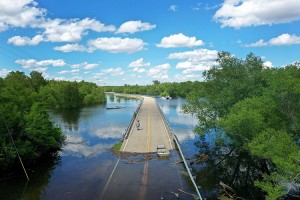Spring Floods and Tornadoes
Friday, June 21st, 2019June 21, 2019
Today, June 21, is the first day of summer, and people in parts of the Midwestern and Southeastern United States can say goodbye to a stormy spring that included record flooding and an unusual number of powerful tornadoes. Beginning in March, snowmelt and repeated heavy rains overflowed the Arkansas, Mississippi, Missouri, and other rivers. Tornadoes ravaged many areas in March and April, and in the month of May alone, an astounding 362 twisters touched down in 12 different states. The combined spring storms killed 64 people and caused billions of dollars worth of damage.

Mississippi River floodwaters cut off a highway at the Illinois-Missouri border on May 30, 2019. Spring storms ravaged many parts of the Midwest and Southeast in 2019. Credit: © Scott Olson, Getty Images
An unusually cold winter resulted in large snowfalls and frozen ground throughout the Midwest. In March, melting snow added large amounts of water to streams and rivers. Torrential downpours then followed, resulting in floods that affected Arkansas, Illinois, Iowa, Kansas, Missouri, Nebraska, Oklahoma, South Dakota, and Wisconsin. Six people died in the regional flooding, and the waters caused some $8 billion in damage. Powerful thunderstorms and flooding continued in April and May, spreading damage to the states of Florida, Kentucky, Louisiana, Mississippi, North Carolina, Tennessee, and Texas. In some states, more than a month’s worth of rain (compared with the average) fell in a single day. Saturated fields prevented many crops from being planted, and many existing crops were severely damaged.
In early March, tornadoes first struck in the Southeast, killing 23 people and causing extensive damage in parts of Alabama, Florida, Georgia, and South Carolina. In April, tornadoes killed 20 more people in the states of Arkansas, Louisiana, Mississippi, Missouri, Oklahoma, and Texas. Then, in May, 362 tornadoes killed 15 people across the Midwest. A number of the tornadoes rated EF4—wind speeds of 166 to 200 miles (267 to 322 kilometers) per hour—on the Enhanced Fujita Scale, used to measure a tornado’s intensity. (EF5, with winds over 200 miles (322 kilometers) per hour, is the highest rating.) Destruction was substantial in Dayton, Ohio, and Linwood, Kansas, but no people were killed.
The Midwestern and Southeastern United States are accustomed to bouts of severe spring weather, but this year’s storms were abnormally abundant and strong. The increases in bad weather—in both winter and spring—aligned with what scientists expect as the world’s climate continues to change. As average global temperatures rise, air becomes saturated with moisture, resulting in higher amounts of precipitation. Scientists at the National Oceanic and Atmospheric Administration have warned of increasing episodes of severe weather because of climate change.


